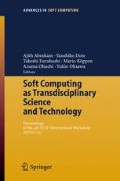7 Conclusion
The usefulness of emulating the foraging behavior of active honeybee colonies as Web explorers that are reactive, proactive, and robust was shown to be feasible. The foraging behavior of honeybees exhibit a pattern of behavior that is directed toward achieving a specific purpose: the maintaince of a dynamic environment map/localized view of hive’s ecosystem. The dynamic nature of Internet user traffic patterns provides ideal environmental conditions that result in stochastic information within WWW.
Access this chapter
Tax calculation will be finalised at checkout
Purchases are for personal use only
Preview
Unable to display preview. Download preview PDF.
References
Berners-Lee T, Cailliau R, Groff J, Pollermann B (1992) Electronic Networking: Research, Applications and Policy l(l):74–82
Clark O, Kok R (1995) The study of ecosystem dynamics using simulation. In: Proc of Canadian Society of Agricultural Institute of Canada Annual Conference
Dill S, Kumar R, McCurley K, Rajagopalan S, Sivakumar D, Tomkins A (2001) ACM Trans. on Internet Technology (TOIT) 2(3):205–223
von Eicken T, Culler DE, Goldstein SC, Schauser KE (1992) Active messages: A mechanism for integrated communication and computation. In: Proc of International Symposium on Computer Architecture
Eraser AS (1968) The evolution of purposive behavior. In: von Foerster H, White JD, Peterson LJ, Russell JK (eds) Purposive Systems. Spartan Books
Free JB (1970) The Social Organization of Honeybees. (Studies in Biology no. 81) The Camelot Press Ltd, Southampton
Fritsch P (2000) Five Mellow Guys Follow Their Dream: A ‘Tall Ship’ in Brazil. In: Wall Street Journal (Western Edition), CXLII(35):Sect A:l (Col. 4), Friday, February 18, 2000
Jung J, Sit E, Balakrishnan H, Morris R (2001) DNS performance and the effectiveness of caching. In: ACM Press, Proc of ACM SIGComm Workshop on Internet Measurement
Lindauer M (1961) Communication Among Social Bees. Harvard University Press, Cambridge, Massachusetts
Myllymaki J (2002) Computer Networks 39:635–644
Oates MJ, Corne DW (2001) Soft Computing 5:297–312
Sandalidis HG, Mavromoustakis K, Stavroulakis P (2001) Soft Computing 5:313–317
Vasilakos AG, Anagnostakis KG, Pedrycz W (2001) Soft Computing 5:264–271
Walker RL (2003) Emulating the honeybee information sharing model. In: Hexmoor H (ed) IEEE Press, Proc of KIMAS 2003
Walker RL (2003) Tocorime Apicu: Design of an experimental search engine using an information sharing model. PhD Dissertation, University of California at Los Angeles, Los Angeles, California
Walker RL (2004) Honeybee search strategies: Adaptive exploration of an in-formation ecosystem. In: IEEE Press, Proc of CEC 2004
Walker RL (2004) Search engine development using evolutionary computation methodologies. In: Tan KC, Lim MH, Yao X, Wang L (eds) Recent Advances in Simulated Evolution and Learning. World Scientific Publishing, Singapore
Walker RL (2005) Journal of Network and Computer Applications 28(2):77–96
Author information
Authors and Affiliations
Editor information
Editors and Affiliations
Rights and permissions
Copyright information
© 2005 Springer-Verlag Berlin Heidelberg
About this paper
Cite this paper
Walker, R.L. (2005). Using the Purposive Behavior of Honeybees as the Basis of an Experimental Search Engine. In: Abraham, A., Dote, Y., Furuhashi, T., Köppen, M., Ohuchi, A., Ohsawa, Y. (eds) Soft Computing as Transdisciplinary Science and Technology. Advances in Soft Computing, vol 29. Springer, Berlin, Heidelberg. https://doi.org/10.1007/3-540-32391-0_100
Download citation
DOI: https://doi.org/10.1007/3-540-32391-0_100
Publisher Name: Springer, Berlin, Heidelberg
Print ISBN: 978-3-540-25055-5
Online ISBN: 978-3-540-32391-4
eBook Packages: EngineeringEngineering (R0)

